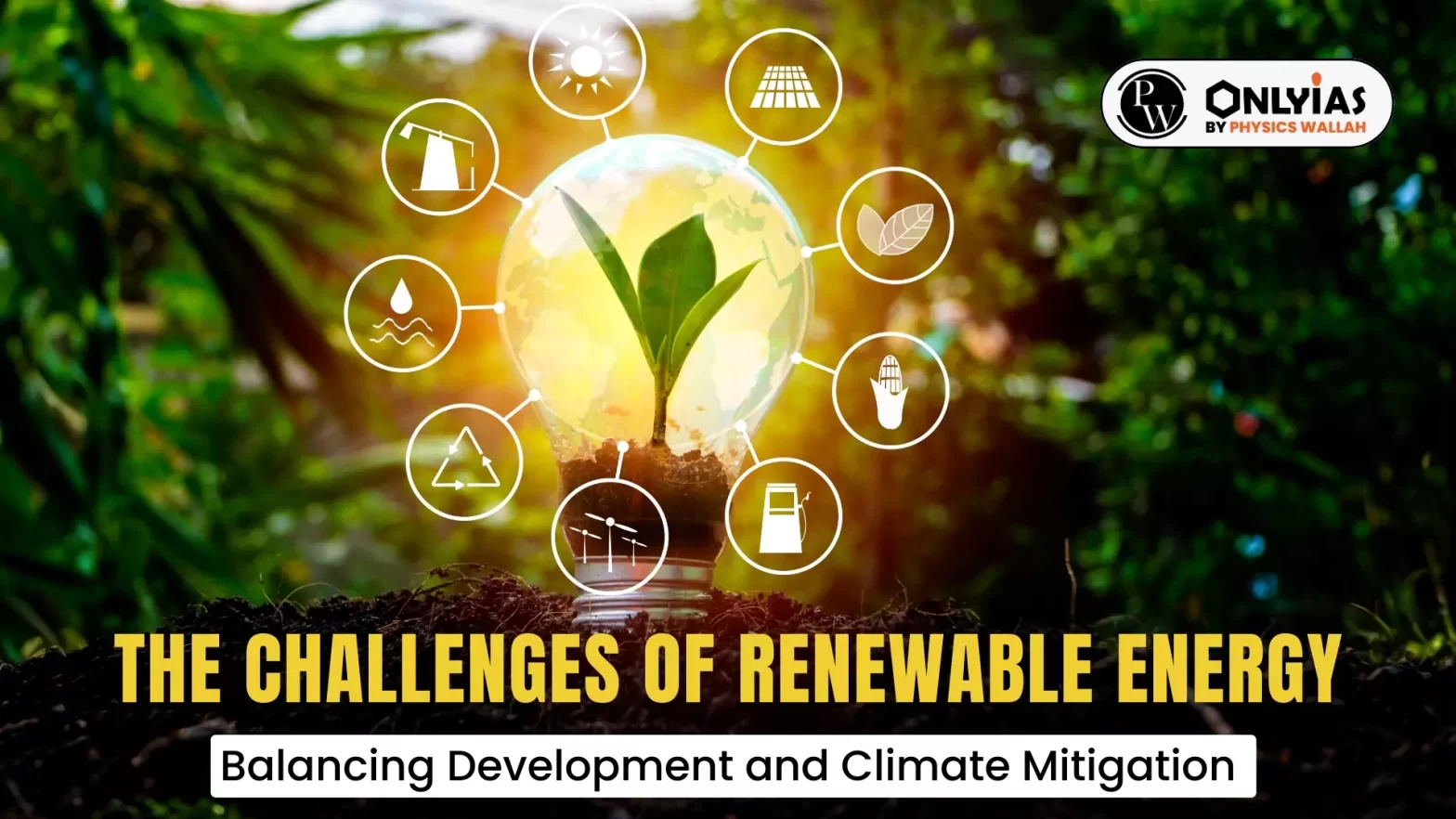Context
Recently, the United Nations Climate Change Executive Secretary emphasized the urgency of the next two years in addressing climate change.
- The complex interplay between development, sustainability, and climate change mitigation poses significant challenges amid environmental concerns and socioeconomic aspirations.
Enroll now for UPSC Online Course
Renewable Energy Challenges in India
- Limited Understanding of Linkages: The linkages between the pathways of development, sustainability, and climate change mitigation are far from well-understood.
- Unsustainable Development Models: Our current models of development drive greenhouse gas (GHG) emissions, are unsustainable, and inequitable.
- India’s Ambitious Net Zero GHG Emissions Target: Although India aims to achieve Net Zero GHG emissions by 2070, mainly led by a massive transition to large-scale renewable energy, the implications of such a transition on developmental or sustainability outcomes are unclear at the local and national levels.
Examining Solar Parks in India
- Role of Large-Scale Solar Parks in India: Large-scale solar parks are central to India’s mitigation strategy, with potential implications for local and national development and sustainability goals.
- Challenge of Land Requirement: India has 214 sq. km of land under solar parks, but some studies estimate that it may need 50,000-75,000 sq. km, which is about half the size of Tamil Nadu, to achieve our Net Zero targets.
- Losses and Protests in Bhadla: In Bhadla, farmers have lost sacred common lands called Orans and pastoralists are faced with shrinking grazing lands, forcing some to sell their livestock at throwaway prices.
- Such losses have led to protests demanding recognition of common land under the Forest Rights Act (FRA), 2006.
- Economic Benefit to Farmers in Pavagada: Many farmers in Pavagada were content with the steady annual income they received by leasing out land for solar parks.
- This land was drought-stricken and did not yield significant agricultural income.
- Water Requirement for Solar Panel Maintenance: Solar panels require large amounts of water for their regular cleaning.
- Lack of Integration of Nearby Water Availability: Yet, our current national-level estimates for the land available for solar parks do not account for the availability of nearby water sources.
- Resource Competition: Solar parks may compete for essential resources like water and land with agriculture, potentially impacting food security and biodiversity.
- Biodiversity Loss: Impacts on biodiversity loss with the construction of large-scale solar parks are also location-specific, and under-researched.
- For instance, open natural systems such as deserts provide essential ecosystem services that, if disturbed, would cause ecological damage and even contribute to climate change.
Different Approaches
- Community Ownership: Community ownership models and involvement in planning processes can promote equitable development and revenue generation from solar parks.
- Exemption from Impact Assessment: Solar and wind park development is exempted from Environmental and Social Impact Assessment.
- Need for Revision and Strengthening of Legal Provisions: The legal and regulatory architecture must be revised and strengthened to limit adverse social and environmental consequences.
- Local Governance Engagement: Involving local governance units in the planning and siting processes can provide an opportunity to align local developmental objectives with solar park development.
- Enhancing Environmental and Equity Outcomes: Wasteland classification and recognition of commons under the Forest Rights Act could improve environmental and equity outcomes.
- Integrating Renewable Energy and Agriculture: Encouraging research and experimentation with agri voltaics can integrate renewable energy production with agriculture, enhancing sustainability.
Other Challenges and Opportunities
- Avian Impact of Wind Energy: Similar issues abound with other mitigation technologies. Wind energy, for instance, has adverse consequences on bird ecosystems.
- Employment Dynamics of Large-scale Renewable Energy Projects: Large-scale renewable energy projects could have positive employment outcomes at the district level, but they lead to massive employment shifts between sectors at the national level.
- Skilling Programs for Socioeconomic Protection: Adequate skilling and training programmes targeting the unskilled and poorer populations are essential to protect them.
Enroll now for UPSC Online Classes
Conclusion
We need to align our technological, economic, and institutional structures to maximise synergies between sustainability, climate change mitigation, and development related outcomes.
Also Read: Green Hydrogen In India
| Prelims PYQ (2015):
With reference to the Indian Renewable Energy Development Agency Limited (IREDA), which of the following statements is/are correct?
1. It is a Public Limited Government Company.
2. It is a Non-Banking Financial Company.
Select the correct answer using the code given below.
(a) 1 only
(b) 2 only
(c) Both 1 and 2
(d) Neither 1 nor 2
Ans: (c) |
![]() 22 Apr 2024
22 Apr 2024

